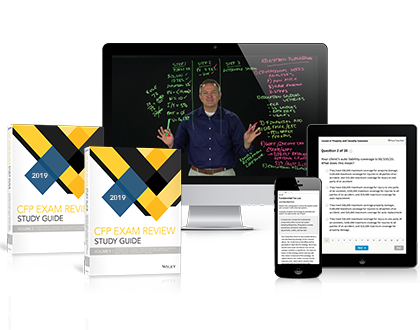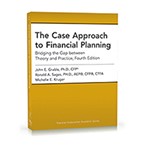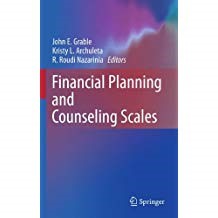Materials Co-Authored or Edited by: John Grable, Ph.D., CFP®
Introduction to Personal Finance: Beginning Your Financial Journey
Publisher: Wiley
There are lots of options available in the personal finance/financial literacy field. While each book provides great information and a unique approach to delivering content, Lance Palmer and I kept running into the same problem: students were not reading the material. This became a problem because we ended up spending so much class time getting students up to speed that we missed opportunities for real engagement. Sound familiar? We felt like the books were missing the mark in terms of building financial literacy and financial capacity. This is the reason we decided to rethink the way personal finance education is being delivered.

This book presents personal finance material in the framework of a lifetime journey (thus the graphic on the book cover). Rather than force students to read through 16 to 18 densely written chapters, our approach is totally modular. This means that instructors can choose what they want students to read and in what order material is covered. Additionally, the topics (which are grouped by chapter) are short, engaging, and fun.
Based on student feedback, this is what we have learned. First, students are finally reading the material! Why? Because the topics fit the lifestyle of 21st century learners. Second, students are using the built in assessments prior to class. This makes class discussions more engaging and fun. Third, students appreciate that the “math” element of the class is focused on practical applications rather than on developing skills to become a financial analyst. Finally, instructors love the idea that they can choose topics to include or exclude from the class with very little disruption to the overall flow of the content delivery for students. It’s easy and simple! For example, one of our colleagues really likes discussing human capital, risk tolerance, and other “interior finance” topics. The course allows him to make these topics visible to students. Another colleague prefers to focus on investment topics so she hides some of the softer topics from student view and allows them to access all of the investment topics.
If you are looking for content
that was developed specifically to make personal finance fun and engaging, this
book is for you.
Communication Essentials for Financial Planners: Strategies and Techniques
Publisher: Wiley (available at: https://www.wiley.com)
The purpose of this book is to provide financial planners insights into improving their communication and counseling skills. The approach presented in the book is based on helping financial planners develop, practice, and use skills associated with the formal and informal sharing of information between a client and the financial planning professional in an empathic manner that enhances the client-financial planner relationship.

This book was written to be a useful resource for both professionals and students who work with clients on a day-to-day basis. The Certified Financial Planner Board of Standards, Inc. (CFP Board)—the primary academic standards setting and enforcement board for college and university programs[i]—has identified communication and counseling skills as an essential element of financial planning competency. Some have even argued that “Effective communication is vital to successful financial planning.”[ii] The content of this book, along with the video examples, can help improve a financial planner’s proficiency (a) when evaluating client and planner attitudes, values, biases, and behavioral characteristics and the impact these have on financial planning; (b) in communicating with clients; and (c) with counseling skills.
CFP Exam Review
Publisher: Wiley
When Wiley—a global publisher with an outstanding track record for developing exam preparation for CPA and CFA exams—approached Swarn Chatterjee, Joe Goetz, Lance Palmer, and me to help develop content for Wiley’s CFP Exam Review, we jumped at the opportunity. The result is the kind of resource we had always wanted to recommend to students. Using our years of combined knowledge, we helped create a set of resources shaped around student needs, providing a comprehensive and user-friendly approach to learning. Some highlights for us are:
- The most important elements of practice are highlighted in a clear and concise way, to develop the students understanding;
- Hundreds of end-of-lesson practice questions, each one aligned to a learning objective;
- The best-in-class video lectures that accompany each learning objective; and
- A remarkable online platform that allows students to focus on learning by organizing their study with a daily task list, reminders, and performance metrics.

Feedback from students has been exceptional, with a great response to both the quality of the course and the value for money in comparison to the competition. Along with a 2-volume Study Guide set, it also includes a full-length mock exam, a 500+ question test bank, more than 1400 online flashcards and 15+ hours of video lectures and so much more. Go ahead and take a look for yourself.
The Case Approach to Financial Planning: Bridging the Gap between Theory and Practice (4th Edition)
Publisher: National Underwriter
The Case Approach to Financial Planning: Bridging the Gap between Theory and Practice, Fourth Edition, fosters sound financial planning logic and decision-making using the CFP Board of Standards, Inc. newly-revised 7-step systematic financial planning process. This textbook provides the tools and foundation for helping aspiring financial planners learn by doing. The material in this book provides students with real-world scenarios that can provide insights into the financial planning process as they put their financial planning skills to the test.

This new edition features:
- A content review of the major subject areas typically taught in a college-level financial planning curriculum;
- A comprehensive review of important financial planning mathematical formulas and procedures;
- A variety of 16 case studies, including an ethics review case.
- Chapter-based case examples that illustrate how financial planning strategies can be used to develop client-specific recommendations;
- End-of-chapter mini-cases with exercises that challenge students to apply chapter content;
- Quantitative/analytical mini cases that feature multiple-choice questions designed to develop a student’s ability to analyze, evaluate, and synthesize data to create appropriate recommendations matched to a client’s needs;
- Chapter-based learning aids, including access to a fully integrated Financial Planning Analysis Excel™ package and other online support materials;
- Completely updated strategies incorporating the provisions of the Tax Cuts and Jobs Act (2017);
- A step-by-step guide to the preparation of a comprehensive personal financial plan.
- Financial planning strategies that can be applied to a variety of clients and client circumstances; and
- Instructions on how to do calculations essential to creating a financial plan.
The Fundamentals of Writing a Financial Plan
Publisher: National Underwriter
Fundamentals of Writing a Financial Plan provides a new and unique approach to helping aspiring financial planners write a comprehensive financial plan. The book shows how the CFP Board of Standards, Inc. newly-revised 7-step systematic financial planning process can be applied when writing a comprehensive financial plan for an individual or family.

The core of the book is focused on writing a comprehensive financial plan. Students learn the writing process by following a running case—Chandler and Rachel Hubble—and observing how elements of a financial plan can be written and presented to clients. This book features:
- A thorough review of the 7-step systematic financial planning process;
- A description of the regulatory environment in which every financial planner operates;
- An in-depth discussion of client communication and counseling techniques;
- Financial planning strategies that can be applied to a variety of clients and client circumstances;
- A chapter-by-chapter focus on analytical tools and techniques that can be used to evaluate client data;
- A complete written financial plan; and
- Chapter-based learning aids, including access to a fully integrated Financial Planning Analysis Excel™ package and other online support materials, including video examples of client communication strategies.
Financial Planning and Counseling Scales
Publisher: Springer
The personal, household, and consumer finance field is growing quite rapidly, especially as universities and policy makers see the need for additional research and clinical application in this dynamic area of study. Currently, the profession is advancing towards the stage where professional practice becomes increasingly evidenced-based. Financial Planning and Counseling Scales provides educators, researchers, students, and practitioners with a much needed review of reliable and valid personal assessment scales and instruments that can be used for both research and clinical practice. In addition to presenting actual scales and instruments with applicable psychometric details, the book also includes an overview of measurement issues and psychometric evaluation.

[i] “CFP Board is a professional certification and standards setting organization founded in 1985 to benefit the public by establishing and enforcing education, examination, experience, and ethics requirements for CFP® professionals. Through its certification process, CFP Board established fundamental criteria necessary for competency in the financial planning profession.”
[ii] Sharpe, D. L., Anderson, C., White, A., Galvan, S., & Siesta, M. (2007). Specific elements of communication that affect trust and commitment in the financial planning process. Journal of Financial Counseling and Planning, 18(1), 2-17. grateMute=!0